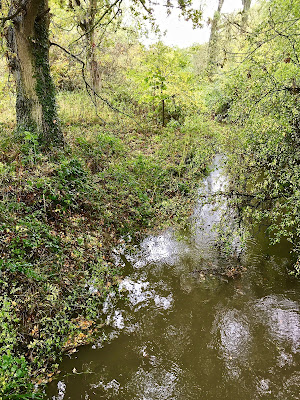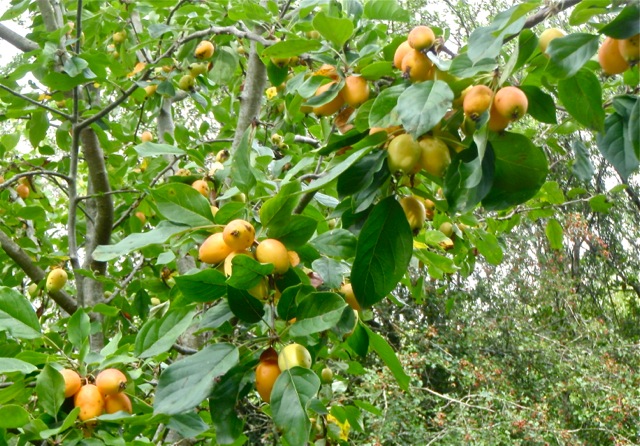The 26th November was another dark and cloudy day but slowly brightening. We can now see how important hedges are for wildlife. A thin, closely-cropped decorative hedge with tidied and raked roots is not much use, providing no cover or sustenance for wildlife. A genuine old hedgerow would have been planted for a good reason, always strong and dense enough to prevent a rampaging bull or herd of stock from breaking through and escaping onto a neighbouring farm or disappearing down the lane. Wildlife would take full advantage of these old species-rich hedgerows which would always contain berry and fruit-bearing species and remain year on year. If you can see through a hedge in winter - it's not good enough.
Spindle fruits - an unusual clashing mix of colours - bright pink with bright orange seeds. This occurs in ancient woodlands and old species-rich hedgerows growing at random mixed in with other hedgerow plants. It's unnoticed until the autumn when the fruits ripen. As with some other fruits birds can cope with the inedible seeds. It's one of the most favoured by robins which claim and guard 'their' bush.
Blackthorn is a good hedgerow example, with an unruly and generous habit sending out shoots in all directions from roots to the very top, swathed in blossom in early spring and bearing sloes in autumn in time to provide sustenance to flocks of winter migrants together with our resident thrushes.
On 26th, after high water levels on 15th, the river was flowing well but had done no damage. A Blackthorn tree branch had spread itself across the river, an old branch covered with lichen and sloes, presenting no difficulty for most birds trying to reach the fruits. Overhead a typical winter sight, a small flock of pied wagtails flew over heading south whilst house sparrows (about 60) were active in small groups flying across and calling from hedges. Many were just visible under dense bramble picking at seed heads of uneaten blackberries and thistles. Good numbers of robins (26) were now singing loudly, several answering each other along the banks and Hazels. Four Dunnock were seen, two of them on a path and the others into a hedge. It was good to see increasing numbers of wrens now (15) , most visible flying low from undergrowth and banks and a few now singing.
Other small birds, blue ts (27) and great ts (15) were calling and moving quickly from tree to tree and a single coal t was seen in a hedge. Of the finches, only a single chaffinch was present and again no greenfinches. About 20 goldfinches were active, five flying across in a group and about 15 singing from a thicket together. A bullfinch was heard calling for a second, on the opposite bank and a winter blackcap was present in a thicket nearby. Three goldcrests were seen moving fast amongst the needles of pines further south.
Loud calls came from a great-spotted woodpecker which gave good views perched on a branch directly above whilst eating an unknown item. There were very good views too of a treecreeper creeping up branches of a bare tree. It soon moved aside onto an oak, a far more interesting tree. As usual, nuthatches were present (4), one calling from a maple and the others in various oaks along the river. They seemed to know each other and were probably related.
Blackbirds,( 41), their numbers augmented by visiting birds from Eastern and Northern Europe, were perched on the Blackthorn or foraging in the dense undergrowth, the migrants probably recognised by their heavier build. Two fieldfare, definitely migrants, were also seen amongst them. Later they were joined by a few redwing (9) also definitely winter migrants, reaching out to grasp and eat sloes as they made their way along the hedges. Song thrushes (5) were more elusive, foraging low, darting into undergrowth and brambles - one gave a very short song from a branch.
Looking up, several carrion crows (13) were scattered in various trees, three in an old oak calling loudly, whilst others selected similarly high lookout perches. The loudest were the jays (5) again appearing very aggressive and unusually visible. 14 herring gulls and only two starlings were seen flying across the river together and 6 magpies flew into trees, strangely silent. A single jackdaw flew across the woods.
The most memorable bird today was a sparrow hawk which suddenly flew out of a thicket across to a tall hedge. It made a level dash into the branches and set up many birds including at least 30 wood pigeons which all flew up together whist the smaller birds scattered in all directions. All along the riverside there were about 65 wood pigeons in various places.
The sparrow hawk was unsuccessful and the birds settled again after a while but then were all set up again by a police helicopter which arrived to hover over the bridge area, circle for some time then disappear. For the second time the birds returned and settled once more. After this the sparrow hawk was seen again (or could have been a second one) this time perched in a tall tree not far away.

























